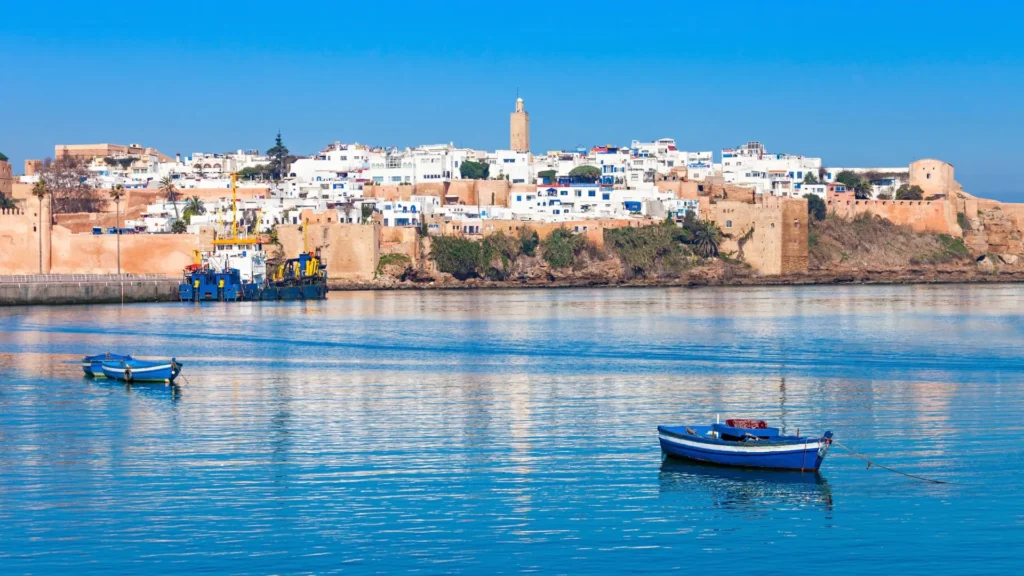Introduction: Beyond the Tourist Trail
As the sun dips below the golden dunes casting long shadows across the ancient landscape, I’m reminded of why I’ve dedicated my life to unveiling the true magic of the Sahara. My name is Fayssal, and for over two decades, I’ve guided travelers through Morocco’s desert landscapes – not just along the well-trodden paths that fill Instagram feeds, but to the secret corners that only generations of desert dwellers know.
What began as a childhood fascination with the endless sands of my homeland evolved into a lifelong passion. While most guides follow predictable routes, my journeys are different. Between official luxury desert tours in Morocco, I venture alone into the vast Sahara, befriending nomadic families and elderly village residents who’ve entrusted me with knowledge passed down through centuries – locations where ancient trading caravans once rested, hidden oases untouched by tourism, and viewpoints where the desert sky performs its most spectacular shows.
This article isn’t another generic overview of Morocco’s desert attractions. Consider it your insider’s guide – the accumulated wisdom from countless expeditions and quiet conversations with those who know the Sahara as intimately as they know themselves. Whether you’re planning your first Sahara camel trip or you’re a seasoned desert traveler seeking deeper experiences, I’m about to share secrets that most commercial guides either don’t know or deliberately keep hidden.
Table of Morocco Desert Tour
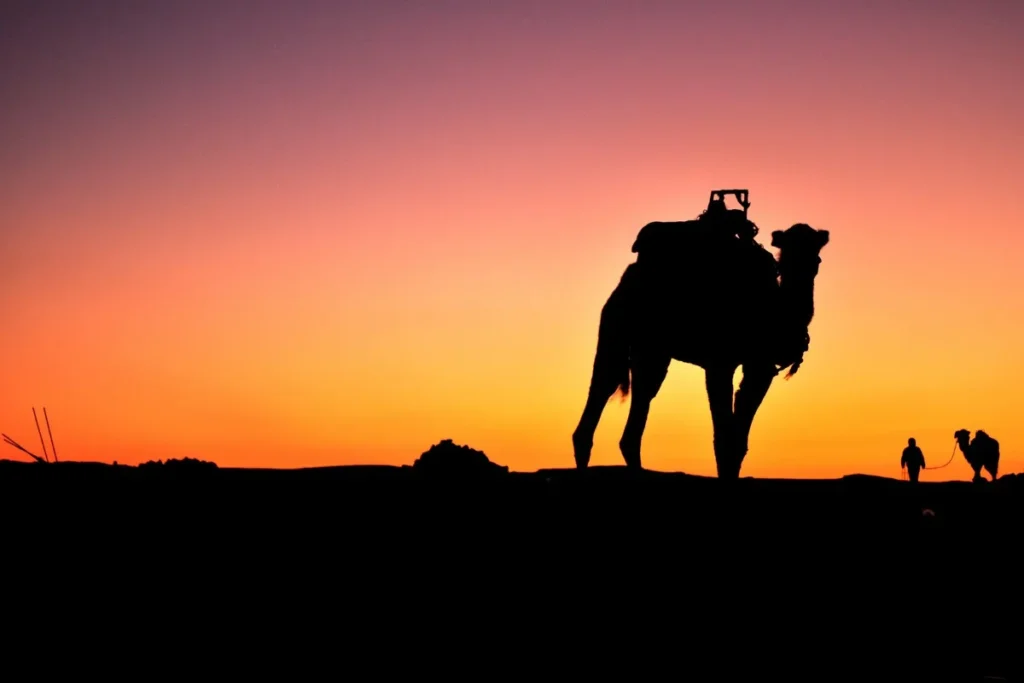
The Real Magic Hours: Sunrise and Sunset Spots Most Tours Miss
Dawn at Erg Znagui: The Forgotten Morning Ritual
Most Morocco desert tours rush tourists to Erg Chebbi for sunrise, creating a crowded experience that diminishes the desert’s natural serenity. However, approximately 15 kilometers south lies Erg Znagui, a collection of dunes that local shepherds have revered for generations. Here, the first light creates a phenomenon locals call “the whispering sands” – as sunlight gradually warms the cool night air, the temperature difference causes subtle sand movements that create a soft hissing sound.
I discovered this spot during my third solo expedition when I followed a Berber elder simply known as “The Desert Walker.” He explained that his grandfather brought him here as a boy, claiming the morning light reveals the desert’s true spirit. Unlike the tourist hotspots, you’ll rarely encounter another soul at Erg Znagui, allowing for a genuinely spiritual connection with the landscape.
To reach it, you must leave your camp by 4:30 AM and navigate using distinctive rock formations visible even in dim light. This extra effort explains why standard Sahara desert trips skip this location – it doesn’t fit neatly into convenient itineraries.
The Ridge of Ancestors: Sunset’s Secret Theater
The most spectacular sunset viewing point remains virtually unknown to commercial tours. Locally called “Tislatine n’Imaldiwen” (Ridge of the Ancestors), this elevated sandstone formation near the Algerian border offers a 270-degree panorama that transforms the evening sky into nature’s most impressive light show.
I discovered this location purely by chance during a private tour when our vehicle developed mechanical issues. A local goatherd named Ibrahim invited us to wait at this ridge while he fetched help from his village. As the sun began its descent, I witnessed colors I didn’t know the sky could produce – deep purples melting into burnt oranges and golds so vibrant they seemed almost liquid.
Ibrahim later explained that his tribe had used this location for centuries to determine seasonal changes based on precisely where the sun touched the horizon. The geographical positioning creates unique light refraction patterns not visible elsewhere. Now, I bring select clients on my luxury desert tours Morocco experiences to this spot, timing our arrival precisely 45 minutes before sunset to witness the full spectacle.

Hidden Oases: The Desert’s Secret Gardens
Ain Tamezguida: The Forgotten Oasis
While tourist maps mark the famous oases like Fint and Skoura, the truly magical water sources remain unlisted. Ain Tamezguida ranks among the most spectacular – a spring-fed collection of pools surrounded by surprisingly lush vegetation that has sustained desert travelers for centuries.
I first learned of this place from an elderly woman named Fatima during a Morocco private tour with a family seeking authentic experiences. When I mentioned we were looking for something beyond the standard attractions, she sketched a rudimentary map on a piece of paper, pointing to landmarks only locals would recognize. “Most guides don’t go there,” she explained, “because the approach is difficult and they fear their vehicles might get stuck. But it’s where we went as children when the summer heat became unbearable.”
Following her directions required navigating a seemingly impassable series of rocky outcroppings. Just when I thought we’d taken a wrong turn, the landscape suddenly opened to reveal a verdant paradise. Date palms swayed around crystal-clear pools, with small fish visible darting through the depths. The encircling rock formations create a natural amphitheater that amplifies the sound of falling water – what locals call “the desert’s heartbeat.”
During extreme summer heat, nomadic families still bring their livestock here, following traditions unchanged for centuries. Visit early morning or late afternoon when the water reflects the changing light. This oasis doesn’t appear on any official Sahara desert trip itinerary, but with proper guidance, it’s accessible with high-clearance 4×4 vehicles.
The Three Sisters: Connected Underground Springs
Another remarkable discovery came through my friendship with Omar, a salt trader who traverses routes largely abandoned since caravans gave way to motorized transport. During one particularly grueling journey, he led me to what appeared to be three unremarkable depressions in the landscape.
“Watch,” he said, dropping a small stone into the first depression. Moments later, ripples appeared not just there, but sequentially in all three spots. These depressions, known as “The Three Sisters,” represent a marvel of natural hydrology – three separate surface pools connected by underground channels, forming part of a vast subterranean water system.
The locals believe these waters have healing properties, particularly for skin ailments. More fascinating is how the surrounding vegetation changes subtly around each pool – different mineral contents in each create distinct micro-ecosystems. During my luxury desert tours Morocco experiences, I sometimes bring clients here for picnic lunches, explaining the geological marvel beneath us while they enjoy the unexpected greenery.
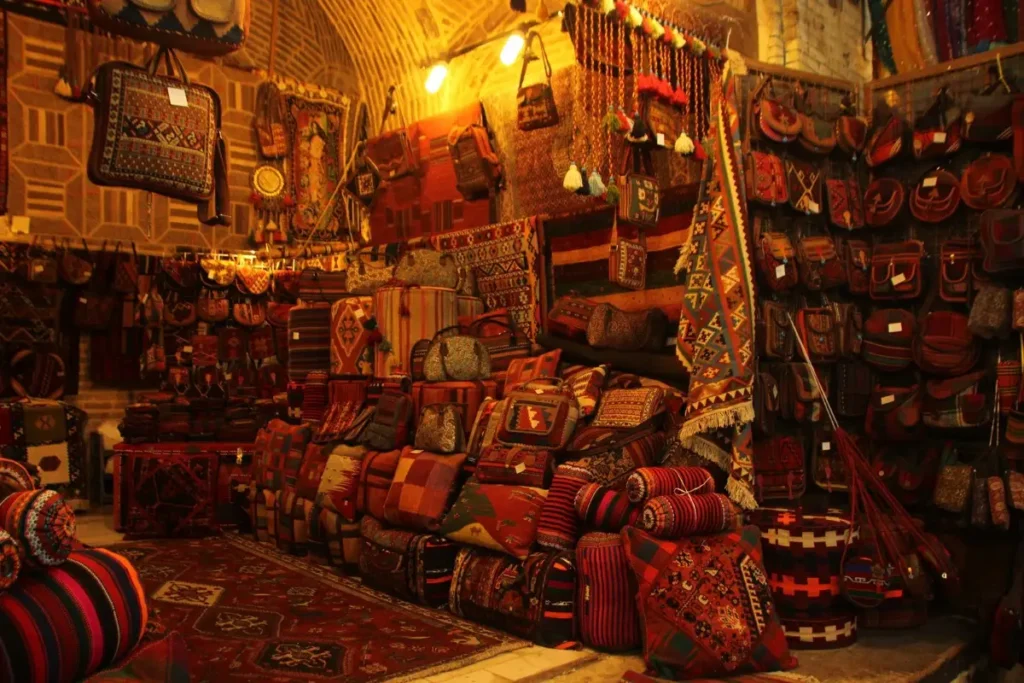
Nomadic Encounters: Authentic Cultural Experiences
The Weekly Desert Markets Most Tourists Never See
While Morocco desert tour operators often include visits to regional markets like those in Rissani, the authentic desert trading traditions happen at smaller, nomadic gathering points that shift locations based on seasonal migrations. These “phantom markets” materialize before dawn and disappear by midday, leaving no trace except compacted sand.
My first encounter with these markets came through Hussein, a camel herder who invited me to join him on his weekly trading journey. We departed his camp at 3 AM, navigating by starlight until we reached what appeared to be an empty plain. Within an hour, dozens of nomadic traders had arrived silently from all directions, creating an impromptu marketplace illuminated only by small oil lamps.
Unlike tourist-oriented markets, these gatherings focus on essentials – camel milk, medicinal plants, hand-crafted tools, and information exchange. Transactions often occur without money changing hands, relying instead on complex bartering systems. The market’s location constantly shifts, communicated through an informal network that outsiders rarely penetrate.
For travelers seeking authentic cultural immersion during their Sahara camel trips, these markets offer glimpses into desert commerce unchanged for centuries. However, access requires both connections and respect for tribal protocols – visitors should never photograph without explicit permission and should understand that they’re witnessing community survival mechanisms, not tourist attractions.
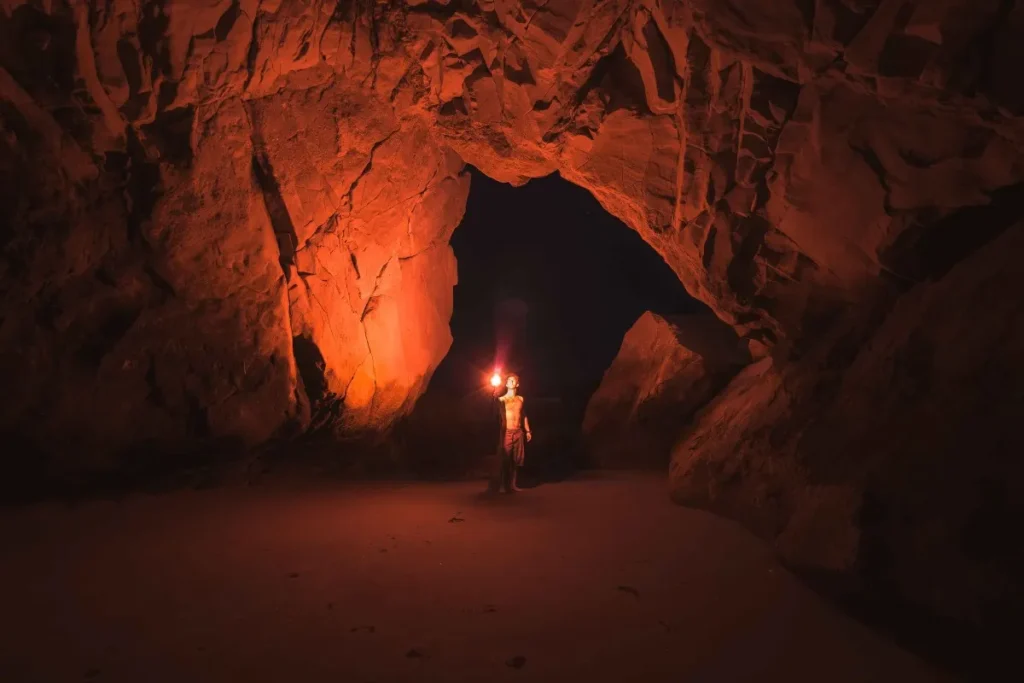
The Cave of Stories: Ancient Petroglyphs Off the Mapped Routes
Approximately 40 kilometers northeast of M’Hamid exists a sandstone formation housing one of the Sahara’s most impressive collections of prehistoric rock art. Unlike the famous petroglyphs at sites like Tazzarine that feature on standard Morocco desert tour itineraries, this location – known locally as the “Cave of Stories” – remains absent from guidebooks.
I discovered this site during a severe sandstorm when seeking shelter with Ahmed, an elderly nomad who had spent his entire life in this region. As visibility deteriorated, he led me confidently to a rock overhang that widened into a shallow cave. Once inside, he illuminated the walls with his small torch, revealing hundreds of ochre and manganese drawings depicting hunting scenes, astronomical observations, and domestic life dating back approximately 8,000 years.
More remarkable than the art itself was Ahmed’s interpretation. His tribe maintains oral histories connecting their current traditions directly to these ancient images. He pointed to a particular hunting formation drawn on the stone, then demonstrated how his people still arrange themselves in the same pattern when tracking gazelle – a living connection to prehistoric survival techniques.
For those on a morocco private tour seeking deeper historical connections, this site offers profound insights into human adaptation to extreme environments. However, its precise location remains guarded to prevent potential damage from uncontrolled tourism. Access requires establishing relationships with local families who serve as both guides and site protectors.
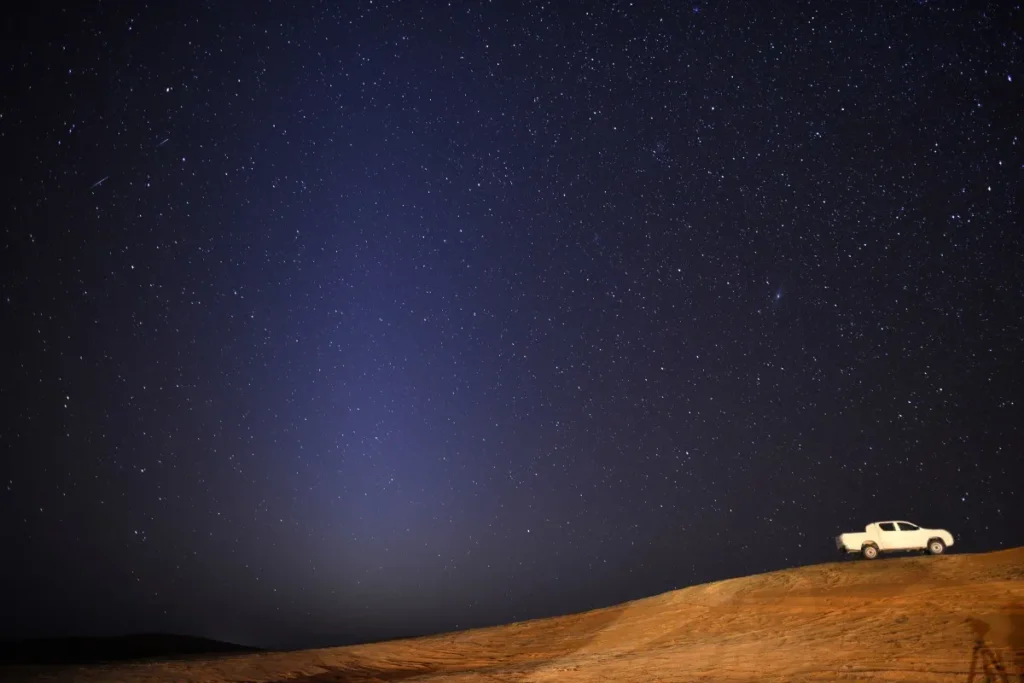
Celestial Wonders: Star-Gazing Beyond Imagination
The Black Stone Valley: Nature’s Perfect Observatory
Standard luxury desert tours Morocco operators typically include stargazing in their packages, but they rarely venture to what astronomy enthusiasts consider the Sahara’s premier viewing location. Locally called “Igoudar n’Tizin” (Valley of Black Stones), this depression approximately 25 kilometers from Zagora features unusual geographical characteristics that create optimal star-viewing conditions.
The valley’s black basalt stones absorb daytime heat but cool rapidly after sunset, preventing the thermal interference that distorts stellar observation elsewhere. Additionally, surrounding rock formations block peripheral light without obstructing the sky view. Most importantly, this location sits at the convergence of air currents that naturally clear atmospheric dust – a rare phenomenon in desert environments.
I first experienced this location’s extraordinary qualities during a private expedition with Lahcen, an elderly herder who navigates exclusively by stellar orientation. He brought me here specifically to demonstrate how clearly the night sky reveals itself. “Our ancestors could see stars here that disappeared generations ago,” he explained, referring to how light pollution has gradually obscured celestial bodies visible to previous generations.
For serious astronomers on Morocco desert tours, this location offers unparalleled viewing of deep space objects typically requiring specialized equipment elsewhere. The Andromeda Galaxy appears distinctly visible to the naked eye, while the Milky Way creates such pronounced illumination that reading becomes possible without artificial light during peak viewing conditions.
The Ancient Calendar Stones: Astronomical Alignments
While researching historical caravan routes for customized morocco private tours, I encountered references to stones used as seasonal markers by desert travelers for millennia. Following these descriptions led me to discover a semi-circle of standing stones approximately 60 kilometers east of Merzouga, positioned precisely to track celestial movements.
Local shepherd Mohamed explained their significance: “Our grandparents used these stones to know when to move their herds. When sunrise touches that tallest stone, the summer rains begin within seven days.” Archaeological evidence suggests these stones have been continuously used for at least 3,000 years, with periodic adjustments to maintain their astronomical accuracy.
What makes this site particularly special for Sahara desert trip enthusiasts is its functional nature – unlike better-known megalithic structures preserved as historical monuments, these stones remain actively used by nomadic populations for timing seasonal migrations and agricultural decisions. Visiting during solstices or equinoxes allows observation of perfect alignments that demonstrate sophisticated astronomical knowledge developed through generations of desert living.
Desert Wilderness: Landscapes Beyond Imagination
The Colored Canyons of Oued Rheris
While Morocco’s famous Todra and Dades gorges attract thousands of visitors annually, the truly spectacular canyon systems remain virtually unknown to commercial tourism. Following ancient water courses through the desert reveals landscapes of breathtaking beauty and geological significance.
The most remarkable of these hidden treasures lies along tributaries of Oued Rheris, where erosion has carved a network of slot canyons displaying striated sedimentary layers in colors ranging from deep purple to vibrant copper. I discovered these formations while tracking historical nomadic migration routes for a research project, noticing narrow entrance points that widened dramatically into cathedral-like chambers.
Local shepherd Ibrahim explained that these canyons served as emergency water sources during droughts, with specific chambers known to collect and preserve rainfall for months through natural geological features. More fascinating are the acoustic properties – certain sections create natural amplification that desert musicians have utilized for generations, creating haunting melodies that resonate throughout the stone corridors.
For adventurous travelers seeking extraordinary photographic opportunities during their Morocco desert tour, these canyons offer composition possibilities unlike anywhere else on earth. The interplay of light through narrow openings creates constantly shifting patterns that photographers call “light rivers” – streams of illumination that flow like liquid across the textured surfaces.
The Ghost Dunes: Moving Landscapes
Approximately 35 kilometers southwest of Erg Chegaga exists a dune system that defies conventional understanding of desert landscapes. Unlike static dune formations featured in typical Sahara camel trips, these “ghost dunes” undergo complete transformation with each major wind event, disappearing entirely only to reform in different configurations.
This phenomenon results from unique mineral composition and specific wind corridor effects that accelerate sand movement beyond normal rates. I first encountered these shape-shifting dunes while guiding an extended Morocco private tour for geologists studying desert formation processes. Even they were astonished by the landscape’s mutability – areas photographed in the morning had sometimes completely rearranged by afternoon.
Local tribes view these dunes with spiritual significance, considering them manifestations of desert spirits constantly reshaping their domain. Tracking specialists use them as training grounds, teaching younger generations how to read constantly changing surfaces – crucial survival skills in environments where landmarks regularly disappear.
For travelers seeking the mystical aspects of desert landscapes, camping near these ghost dunes provides an unforgettable experience of nature’s impermanence. The constant soft hissing of moving sand creates what locals call “the breath of the desert” – a meditative soundtrack accompanying the landscape’s continuous transformation.
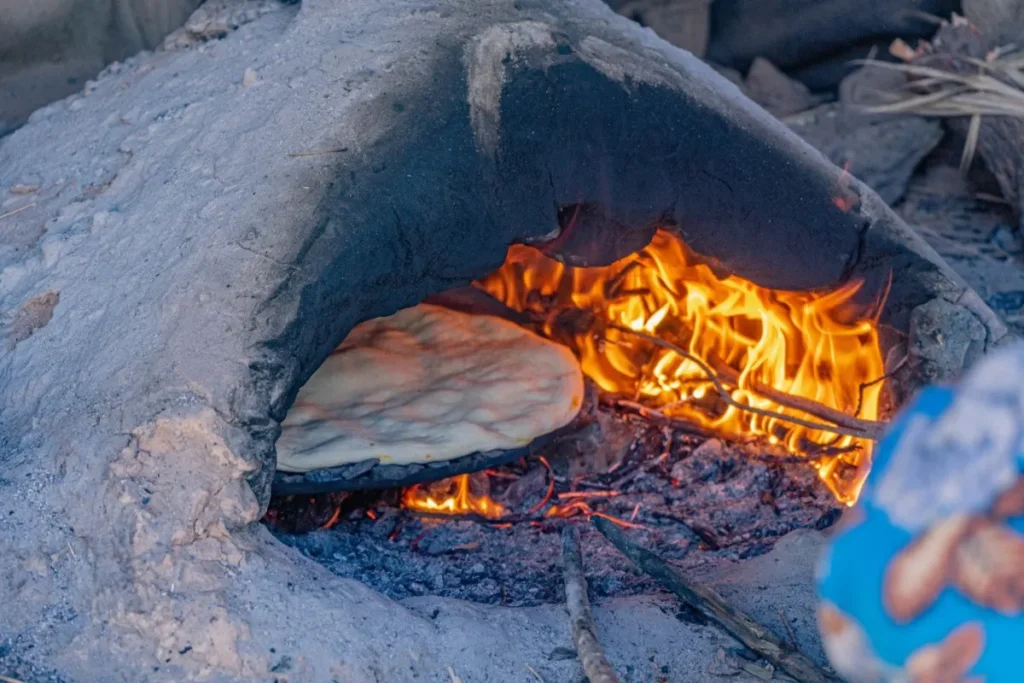
Culinary Secrets: Desert Gastronomy Beyond Tourist Menus
Underground Bread Ovens: Desert Baking Traditions
While standard luxury desert tours Morocco operations typically serve bread prepared in conventional methods, authentic desert cuisine utilizes techniques evolved specifically for extreme environments. Among the most fascinating is the underground bread oven tradition maintained by nomadic communities.
I first encountered this practice while sheltering from a sandstorm with a Berber family near the Algerian border. As conditions worsened, my host Ibrahim calmly began digging a cylindrical hole approximately one meter deep. He lined this cavity with specific stones collected nearby, then built a fire using acacia wood. Once the stones reached proper temperature, he removed most embers, placed specially prepared dough directly against the hot stones, and covered everything with sand.
Ninety minutes later, he unearthed perfectly baked bread with distinctive mineral notes imparted by the stone-cooking process. This method requires no permanent structures or equipment beyond a simple digging tool, making it ideal for nomadic populations. More importantly, it conserves precious fuel resources, requiring minimal wood compared to above-ground methods.
For culinary enthusiasts on morocco private tours, participating in this bread-making tradition offers insights into desert adaptation strategies that transform environmental constraints into gastronomic advantages. The resulting bread develops complex flavor profiles impossible to replicate using conventional ovens.
Desert Truffles: The Sahara’s Hidden Delicacy
Few visitors realize the Sahara produces some of the world’s most prized truffles, harvested during brief windows following specific weather conditions. Unlike European varieties, desert truffles (terfez) grow symbiotically with specific native plants in seemingly barren landscapes, requiring specialized knowledge to locate.
I learned truffle-hunting techniques from Aisha, an elderly woman renowned for her uncanny ability to detect these subterranean treasures. During early morning expeditions, she taught me to identify subtle surface cracks indicating growth beneath, as well as recognizing companion plants that signal potential truffle zones.
The culinary applications extend far beyond the simple preparations offered on commercial Sahara desert trips. Traditional preservation methods transform these seasonal delicacies into year-round ingredients through specialized drying processes that concentrate their earthy flavors. When rehydrated in specific herbal infusions, these truffles form the foundation for remarkable dishes rarely served to visitors.
For gastronomic adventurers, participating in truffle hunts during the brief spring harvest season (typically February to April, depending on rainfall patterns) provides both culinary discoveries and deeper understanding of desert resource utilization – crucial knowledge that has sustained populations in extreme environments for millennia.
Practical Tips for Experiencing the Hidden Sahara
Beyond Standard Morocco Desert Tour Packages
While established tourism companies offer convenient access to major attractions, experiencing the authentic Sahara requires different approaches. Consider these strategies for discovering the desert’s hidden dimensions:
- Extend Your Timeline: The most remarkable desert experiences rarely conform to standard 3-5 day itineraries. Allow flexibility for unplanned discoveries and weather-dependent opportunities. The genuine magic often happens when you surrender to desert rhythms rather than rigid schedules.
- Seek Local Connections: Establish relationships with desert residents rather than relying exclusively on commercial guides. Simple gestures like sharing meals or participating in daily activities often lead to invitations that commercial money cannot buy.
- Consider Shoulder Seasons: The optimal periods for exploring hidden locations occur during transitional seasons – late October through November and March through April. During these periods, temperatures remain manageable while tourist numbers decrease significantly.
- Develop Specific Interests: Whether astronomy, traditional medicine, nomadic architecture, or desert ecology – developing knowledge in particular aspects of desert life opens doors to specialized experiences. Local experts enthusiastically share knowledge with genuinely interested visitors in ways impossible during general sightseeing tours.
Customizing Your Morocco Private Tour Experience
For those seeking truly exceptional desert experiences, consider these approaches for customized journeys:
- Extended Stays at Single Locations: Rather than constantly relocating, consider deeper exploration of specific areas. Many desert phenomena require patience – spending three consecutive nights observing the same dune system reveals transformations invisible to those merely passing through.
- Combined Transportation Modes: While 4×4 vehicles provide efficient access to remote regions, incorporating traditional transportation creates profoundly different experiences. Consider partial camel journeys complemented by vehicular support, allowing immersion in traditional travel rhythms while maintaining comfort and safety margins.
- Satellite Communication Safety: When venturing beyond standard routes, invest in satellite communication technology. The freedom to explore remote areas requires responsible safety protocols, particularly given the desert’s rapidly changing conditions.
- Cultural Exchange Focus: The most meaningful desert experiences typically involve genuine exchange rather than observation. Consider bringing specialized knowledge or skills to share with local communities – creating balanced interactions rather than extractive tourism relationships.
Conclusion: The Desert’s Endless Secrets
After decades exploring Morocco’s desert landscapes, I’ve come to understand that the Sahara never fully reveals itself to visitors merely passing through. Each journey uncovers new dimensions of this extraordinary environment – geological wonders, cultural traditions, and natural phenomena that defy easy categorization.
The hidden gems described in this article represent merely fragments of the desert’s endless secrets. What makes these experiences special isn’t just their exclusivity, but how they connect travelers to deeper understanding of human adaptation and environmental wisdom. In an age of mass tourism and standardized experiences, the authentic Sahara remains available to those willing to venture beyond conventional pathways.
Whether you choose a luxury desert tours Morocco experience or a more adventurous Sahara camel trip, remember that the desert’s most profound offerings rarely appear on itineraries or travel brochures. They emerge through patience, curiosity, and willingness to embrace the unexpected – qualities that transform ordinary tourism into genuine discovery.
For those seeking deeper connections with Morocco’s desert landscapes, we offer both structured luxury experiences through our 5-Day Luxury Sahara Desert Tour and fully customized journeys tailored to your specific interests via our Custom Tours in Morocco service. Whichever path you choose, the authentic Sahara awaits – a landscape of endless fascination that reveals its truest magic to those who approach with open hearts and genuine curiosity.
About the Author: Fayssal has guided desert journeys throughout Morocco for over 20 years, specializing in connecting travelers with authentic Saharan experiences beyond standard tourist routes. When not leading expeditions, he continues exploring remote desert regions, documenting traditional knowledge, and maintaining relationships with nomadic communities throughout the region.


